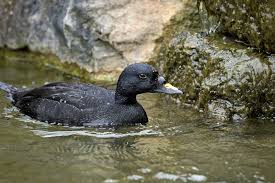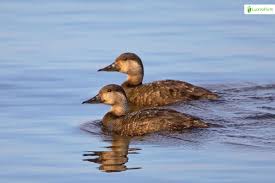Common Scoter (Sjöorre)


Characteristics:
The Common Scoter is a medium-sized sea duck (length 44–54 cm) with a robust body and long neck.
- Male: Entirely black plumage with a distinct yellow patch on the black bill, a key identification feature.
- Female: Dark brown with paler cheeks and underparts, and a less pronounced bill pattern.
Both sexes have dark eyes and a rounded forehead with a sloping bill, giving the species a characteristic silhouette.
Habitat:
The Common Scoter breeds in northern Sweden, mainly in mountain lakes and tundra wetlands, but also along coastal areas of Norrbotten. During migration and winter, large flocks gather along the west and south coasts, often far offshore.
Behaviour:
The scoter is an excellent diver, spending most of its time on the water. It usually flies low over the waves in tight, fast-moving flocks. During the breeding season, it is more secretive and often found in pairs or small groups near freshwater.
Diet:
The Common Scoter feeds mainly on mussels, snails, crustaceans, and small fish. It dives deeply, staying underwater for up to 30 seconds while foraging.
Reproduction:
Breeding takes place in May–July. The nest is built close to water, well hidden in vegetation. The female lays 6–10 eggs, which she incubates for 27–30 days. The ducklings are precocial and leave the nest soon after hatching to follow the female to water.
Migration:
The Common Scoter is a migratory bird, leaving northern breeding areas in autumn to winter along the southern Scandinavian coast, Denmark, and western Europe.
Distribution:
The species is found across northern Europe and Asia, as well as Iceland and Greenland. In Sweden, it is most common in mountain regions and along the northern coast.
Hunting:
The Common Scoter is a game bird in Sweden and may be hunted from 21 september to 31 January. Hunting takes place mainly along coastal waters during migration and winter, often as sea duck hunting from boats or blinds.
Firearm class (Sweden):
Hunting is done with a shotgun, typically using pellet size no. 3–5.
Think for the hunting exam:
- Medium-sized diving sea duck with dark plumage.
- Male: all black with yellow patch on bill.
- Female: brown with paler cheeks.
- Breeds in mountain lakes and wetlands, winters along coasts.
- Feeds on mussels, snails, and crustaceans.
- Hunted in autumn and winter with shotgun.
